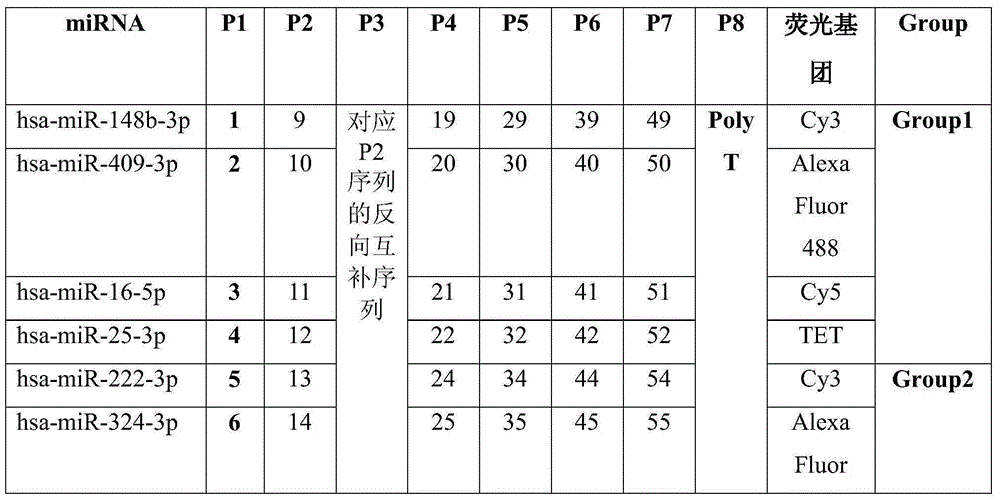Breast cancer related microRNA (Ribonucleic Acid) detection kit
A detection kit and breast cancer technology, applied in the field of molecular biology, can solve the problems of not being able to control the cross-hybridization of probes and non-specific sequences in cells, and the difficulty of simultaneous in-situ detection of expression, etc., to achieve simple design and improved Fluorescence signal intensity, effect of improving detection sensitivity
- Summary
- Abstract
- Description
- Claims
- Application Information
AI Technical Summary
Problems solved by technology
Method used
Image
Examples
Embodiment 1
[0032] Breast cancer related miRNA detection kit
[0033] This embodiment provides a breast cancer-related miRNA detection kit, including a capture probe and a signal amplification probe, the signal amplification probe includes a primary signal amplification probe, a secondary signal amplification probe, and a tertiary signal amplification probe. probe. The above probes have the characteristics of strong specificity and high sensitivity.
[0034] 1. Capture probe
[0035] The capture probe is a probe that connects the target nucleic acid and the primary signal amplification probe. The base sequence of each capture probe is from the 5' end to the 3' end in turn the specific sequence P1 that binds to the target nucleic acid to be detected, the spacer sequence , the P2 sequence that can be complementary to the P3 sequence of the primary signal amplification probe, and the P2 sequences for different target genes are different from each other.
[0036] The spacer is used to spac...
Embodiment 2
[0065] Example 2 A kit for detecting breast cancer-related miRNA
[0066] The invention provides a breast cancer-related miRNA detection kit, which can detect target miRNAs including: hsa-miR-148b-3p, hsa-miR-409-3p, hsa-miR-16-5p, hsa-miR The expression levels of -25-3p, hsa-miR-222-3p, hsa-miR-324-3p, hsa-miR-206 and hsa-miR-105-5p can be used in actual detection according to specific needs The corresponding P1-P8 sequences are used to form a detection kit to realize detection.
[0067] The components of the detection kit in this embodiment include: capture probes, signal amplification probes and fluorescent groups, and the specific probe components are shown in Table 7.
[0068] In this example, hsa-miR-148b-3p, hsa-miR-409-3p, hsa-miR-16-5p, hsa-miR-25-3p, hsa-miR-222-3p, hsa-miR-324- 3p, hsa-miR-206 and hsa-miR-105-5p were randomly divided into 2 groups for detection.
[0069] Table 7 is aimed at the detection kit of specific target gene (table number is SEQ ID NO.)
...
Embodiment 3
[0072] Example 3 Using the kit in Example 2 to detect the sample
[0073] In this example, the kit of Example 2 will be used to detect breast cancer cells.
[0074] The source of breast cancer cells is: breast cancer cell line MCF-7. Those skilled in the art can obtain related cell lines in existing products according to the name of the cell lines.
[0075] The formula of described various solutions is as follows:
[0076]
[0077] All the probes in the corresponding list in Example 2 were used in the signal amplification probe mixture in this example.
[0078] 1. Sample pretreatment, filter CTCs onto the filter membrane
[0079] 1. Preserve the blood sample in the sample preservation tube with preservation solution, centrifuge at 600×g for 5 minutes, and discard the supernatant.
[0080] 2. Add 4mL PBS and 1mL fixative, vortex to mix, and let stand at room temperature for 8min.
[0081] 3. Sample filtration: Transfer the liquid in the sample storage tube to the filter,...
PUM
 Login to View More
Login to View More Abstract
Description
Claims
Application Information
 Login to View More
Login to View More - R&D
- Intellectual Property
- Life Sciences
- Materials
- Tech Scout
- Unparalleled Data Quality
- Higher Quality Content
- 60% Fewer Hallucinations
Browse by: Latest US Patents, China's latest patents, Technical Efficacy Thesaurus, Application Domain, Technology Topic, Popular Technical Reports.
© 2025 PatSnap. All rights reserved.Legal|Privacy policy|Modern Slavery Act Transparency Statement|Sitemap|About US| Contact US: help@patsnap.com



